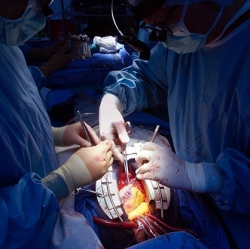
Biocompatible scaffolds, like those developed to stimulate the repair of heart tissue and bone and cartilage in the body, would normally need to be implanted surgically. Now bioengineers at Harvard University have developed a compressible bioscaffold that can be delivered via a syringe before popping back to its original shape inside the body. The material is also able to be loaded up with drugs or living cells that are gradually released as the material breaks down.
The injectable sponge is made up primarily of a seaweed-based jelly called alginate. It is actually a sponge-like gel that is formed through a freezing process called cryogelation. When the water in the alginate solution starts to freeze, pure ice crystals are formed and the surrounding gel becomes more concentrated as it sets. Later, the ice crystal melt to leave a network of large pores that allow liquids and large molecules to easily flow through it. Live cells can be attached to the walls of this network and large and small proteins and drugs can also be held within the alginate jelly itself.
Unlike other alginate gels that are brittle, using this method the researchers were able to produce a strong, compressible gel by carefully calibrating the alginate mixture and the timing of the freezing process.
The research team led by principal investigator David J. Mooney, the Robert P. Pinkas Family Professor of Bioengineering at the Harvard School of Engineering and Applied Sciences (SEAS), demonstrated that cells and drugs can be delivered into the body intact along with the sponge through a small bore needle. Once inside the body, the sponge returns to its original shape and gradually releases its cargo as it breaks down.
“What we’ve created is a three-dimensional structure that you could use to influence the cells in the tissue surrounding it and perhaps promote tissue formation,” explains Mooney. “The simplest application is when you want bulking. If you want to introduce some material into the body to replace tissue that’s been lost or that is deficient, this would be ideal. In other situations, you could use it to transplant stem cells if you’re trying to promote tissue regeneration, or you might want to transplant immune cells, if you’re looking at immunotherapy.”
